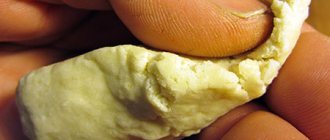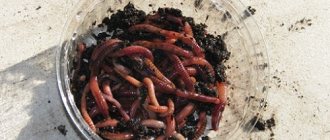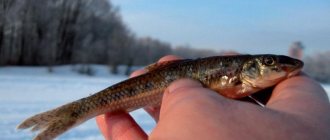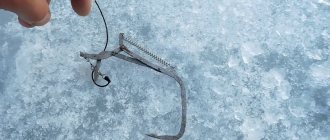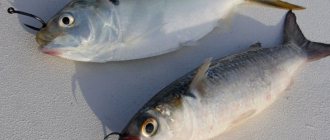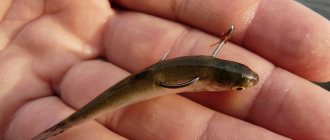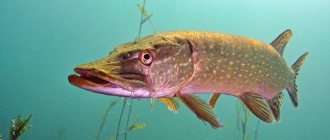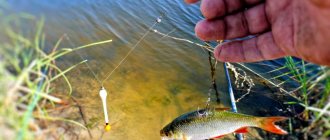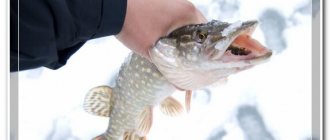Winter fishing for burbot using a snooker and a girder
In this short article we will talk about how to properly catch winter burbot using two fishing methods:
- Tapping (active fishing, requires the direct participation of the fisherman, fishing by tapping bait on the bottom).
- On girders (passive fishing with set flags, the angler only needs to react to a flag flying out of the structure).
We will look at both fishing methods and searching for burbot sites, and video materials will help you understand the fishing technique most fully using the following specified methods.
Fishing with a snitch
Tackle
The snitch is an active tackle and requires the active participation of the angler in fishing. The basis of the gear is:
- Winter fishing rod for trolling pike perch, perch or any other fish
- Monofilament line with a diameter of 0.2-0.25
- A horizontal spoon, a jig head, or just a hook No. 10 according to domestic numbering with a sinker on the winding ring (you don’t need your own action from the bait, the most important thing is the action and the presence of bait on the hook).
Snitching options
Squealer with sprat as bait
Jig heads as snitches
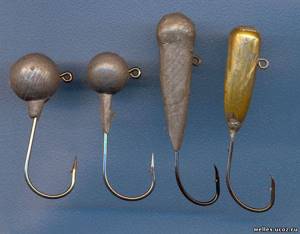
Tappers of various shapes (including those with tees)
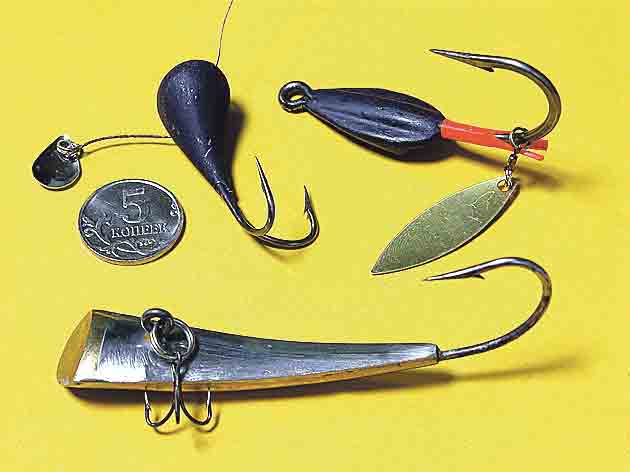
Large snitch with a triangular cross-section
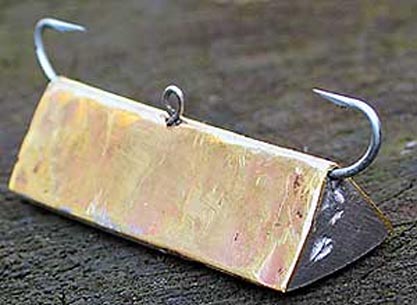
Round tappers
Exotic models of snitches
Bait for catching burbot in winter
- The crawling worm is the number one choice for catching winter burbot (in winter it is problematic to catch it yourself, so you will have to buy it individually at a fishing store).
- Sprat, gudgeon, bleak, topfin - almost any live bait will do, but you need dead fish. It’s good to cut them a little on the sides so that the burbot can smell it. If the fish is a little rotten, this will also play a good role.
- Slicing fish is also very popular. Remember, the most important thing is to play with bait, and its shape and origin are secondary; you can even use defrosted meat (pork or beef).
The process of fishing with a snitch
- The bait is attached to the spoon/jig head/hook and lowered to the very bottom
- The game of the bait can be of several styles in terms of amplitude and frequency of oscillations. You need to experiment and alternate amplitude (the distance at which you raise the bait from the bottom) and frequency (the speed of oscillations).
- Do not overdo it with the frequency, ideally 1.5-3 seconds per oscillation up and down.
- It is better to start the game with an amplitude game (10-15 cm), moving on to a less amplitude game (3-4 cm).
- The burbot grabs the bait hesitantly at first, but when it starts to pull confidently, you should hook it!
- Fishing is problem-free, there is no need to force events, but you should not allow the line to sag.
Catching burbot using girders
Jig tackle for burbot is no different from pike
Tackle
We have already described the girder tackle in the guide to catching pike with girders.
Differences:
- is no need to use a metal or any other leash (except fluorocarbon, although such a leash is more likely for psychological peace of mind for the invisibility of your fishing line) , burbot does not have sharp teeth that can cut the fishing line
- The bait should be kept on the bottom or raised above the bottom by 2-3 cm
- The bite is very careful , so you need to hook only during a clear pull
The baits are the same as those used for snitch fishing:
- crawling worm;
- dead fish;
- slicing fish.
Where and when to look for burbot
You can and should catch burbot from the ice all winter long, until the ice begins to melt, but when fishing on large rivers, you should know that the closer to the end of winter, the further the burbot goes to deep places.
Initially, you should look for burbot near the shores and beaches, on sharp drops to depth. If the coastline has a cape or curvature, this is also a good signal to search for burbot here.
It is best to start your search by placing several girders at potential burbot sites, at depths from 7 to 15 meters. Use a fish finder to correctly determine the depth. You shouldn’t hope that he will show you the fish better, but this can also happen when you find really large specimens.
Fishing for burbot in autumn and spring from the shore - video reviews from professional burbot fishermen.
Pike perch is often caught as bycatch when fishing for burbot; for more details, see the guide to catching pike perch with live bait.
Pike for fishing in winter - the right tackle, choice of live bait and search for a fishing spot.
Comments
I catch burbot at the Cheboksary hydroelectric station (below the ban), the tackle is the same as described above, the bait is king prawn, a worm can be used separately or together (sandwich). We first remove the shell from the shrimp (required). It does not take the shell, only the king shrimp does not take the other.
Vasily, I fish for simple shrimp and for ruffe, he also catches his head well, catches it and goes ahead
I catch burbot in the Murmansk region in exactly the same way as described above, but from the cut I use frozen herring bought in a store, it takes very well and on a worm in January the bite is really not the best, but if I get to its parking lot from one place in a day you can catch up to 5-9 burbot on the snitch and I put wires around it, I go around every half hour if it’s empty, I make several hits on the bottom with a sinker, that also helps
Any live bait will do, but do you need dead fish? Note to the author - live bait cannot be a dead fish!
Burbot is taken not only at depth, but also in shallows from 1 m to 2 m
I fished on the Yenisei Ridge, using ordinary beef stew as bait... I used any tackle where there was a decent size hook. mainly in shallow water (up to 1 m)…
Every year in the winter I put out 10-15 pieces of ruffs, and not because there is nothing to eat, it’s just that in the office the work in front of the computer is sedentary, and so I have to go and check, I check twice a week when I put a small live ruff on the lower lip less often, the ruff lives for a week without problems. The depth is 1-2 meters sand, in February March the burbot goes to the current and 3-4 meters, in severe frosts and sudden changes I go out to knock it when it’s -30, they say that at this time there is no bite, spawning, I don’t agree, there’s a difference between December and February I didn’t see the idea that it was not spawning in unison, I couldn’t find any other explanation, for checking 3-4-5 burbot from 1-3.5 kg. On average, a kilo, one and a half, two, basics. fishing line 0.6 Klinskaya sinker must be blind 80 gr. carabiner, leash 0.35. any hook with a long shank, I don’t take it up to a kilogram, I don’t let it go, there are small ones that sometimes ruin them and swallow them too much, but I came up with a plastic tube and now among small losses there is no such pleasure, multiply 15 holes by the thickness of the ice, you get a figure that will grow weekly so think about it first on a permanent basis. Bashkiria, Ufa, Belaya River, I fish within the city limits. During the season, a stable 45-50 burbot, 10-15 chub, 5 pike-perch are caught.
In March 2015, I went home, stopped by a friend’s dacha on the bank of the Northern Dvina. In the morning we went to check the girders (stick-wire 05-07 meters d 3mm - line 06 did not measure the length - small leash line 03 hook 4.5 number old classification, well, somewhere above there is a sinker, a plate of lead) We take a box with dung worms and leashes. On a hook with a worm, a brush sucks this thing in, and then along the chain we take a burbot ruff, out of seven baits we took two burbot
On the Lena River, a line of 1 -1.2 mm is used for snitching, a large sinker and 2-3 hooks soldered in, it looks like a very large ji head with several hooks, the hooks are very powerful, like for sea fish, but it’s difficult to say the size, the bait is a dead fish if large cut into pieces or a ruff, this is a delicacy for burbot, some add chain links or other trinkets of some kind for sound, and sometimes they hang fireflies, burbot is not indifferent to the light, sometimes it lures it and knock on the bottom, if there is a good place you can take more than 30 pieces in the evening, pecks in the dark
How to mount a shrimp?
We place the unpeeled shrimp on a hook with a long shank from the side of the head with a stocking. After each bite, we check the presence and condition of the nozzle. This is the way to catch trout and carp.
Another way is to thread the hook through the head so that the shrimp is suspended. In this form it will be more mobile. The hook goes through the bottom of the head and comes out about the middle of the head as shown in the picture.
This method is used mainly in bottom fishing.
Another reliable way to bait a shrimp is through the tail.
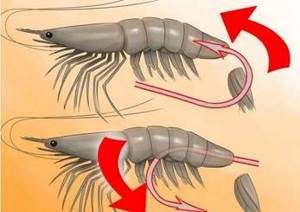
If you need to make long casts, then this method of baiting is optimal. As you can see, the tail comes off. This is done specifically to attract fish. After removing the tail, juice will be released and the pleasant smell of the shrimp will be heard quite far away. Given the fish’s good sense of smell, you can count on quick bites.
Shrimp hold well on hooks with barbs of this type:
The shrimp can also be attached by the tip of the tail. This method is symmetrical to the case when we planted it over the head. In this form, the shrimp remains mobile. It is used in cases where there is a lot of algae, stones and debris at the bottom. This is what it looks like:
Burbot fishing
The end of April, the ice drift and flood have stopped, the water is beginning to subside, but it is still cold and somewhat turbid. Who goes where, and at this time I go for burbot, to small rivers. Having left all the achievements of modern civilization in the garage for fishing, I take with me two dozen banal donkeys. The equipment is the simplest: reel, fishing line 0.6 - 0.7, sinker - a full spoon, homemade (well, these are ounces), hook N10 (according to Soviet numbering), without a leash. I used to do it with a leash, then I gave up, there are a lot of hooks in this fishing, but the thick line has practically no effect on the bite. What else is needed . Of course, a flashlight, preferably a headlamp, if we catch it at night, a newspaper, mark the place where the donk stands, so as not to fumble around in the darkness at night. A hatchet, cut it down and drive in a peg to secure the fishing line. Well, what a bait. The best thing at this time is crawling. It’s not difficult to pick it up by walking around the lawn with a flashlight late at night.
Even in the light I scatter the donks along the shore, I don’t hook the bait. I hang the worm before dusk, otherwise it will eat the little thing. Legal 100 gr. and an hour after dark you can begin walking around the donks. I check everything in a row, where the small bait has eaten, where the donk is not positioned correctly. And where is the fish already sitting? After completing the circle and sitting by the fire for a while, you can start checking the donks again. The active bite is usually until midnight, then it subsides, but not completely. By morning there is another surge of bites.
I don’t put out all the donks at once, I leave three or four, and I carry them with me. (plus a supply of hooks - one type) Either you tear it off, or it swallows it, right up to the guts, I just cut off the hook. At night, sometimes I don’t feel like digging around with broken or tangled gear, I just put a spare one. And add gear in promising places where there were bites.
I place donks both in whirlpools, at depth, and in shallow waters, with the current. There are no patterns where it is better, but more often it bites both here and there.
This fishing is not for the faint of heart, honestly - at this time it’s a little creepy to dart along the river in complete darkness. So, don’t blame me about the legal 100 grams. Sometimes you get wet up to your ears after slipping in the dark. But everything justifies the catch. Burbot, by this time, has reached its maximum reserve of fat in the liver; this is not the goner that was caught in the fall.
Stories about “Burbot, bad weather” definitely do not apply at this time. It is advisable to choose (if possible, of course) a quiet, warm (relatively, well, not hot) night, without a pressure drop. A little rain and wind won’t interfere with the bite, but it’s stupid to wait for it.
. Autumn. The water has cooled down. Mister Nikodim crawled out of the holes. On the subject of getting it to the table, well, let's just say, it's not of the highest quality. During the summer coma, the burbot became quite emaciated and “moldy.” well, nothing, a few weeks after the first morning frosts and it regains its shape a little. Actually, only from this time, and in the middle zone this is mid-October, is it worth starting to catch it. In the Baltics, in November, often from the middle of the month, bay burbot of very trophy size rises into the rivers. People gather like roaches in the spring. The whole river glows from the lanterns. There is no time for an exhibition of a dozen and a half donks. It’s hard to find a place to “stick” a couple of feeder rods. But if you managed to occupy a catchy place, you are practically guaranteed three or even five hefty fish of 3-4 kilograms.
New Year is coming. It's time to get ready to go FISHING - for the pre-spawning feast of burbot. At the very end of the year and before Epiphany, burbot will bite on almost anything, and on any kind of tackle. The easiest way to find it at this time is on rocky fields, where it actually spawns. Not everywhere it is allowed to catch it at this time. For example, on Lake Pleshcheyevo in winter there is a New Year’s ban specifically on the spawning of burbot and vendace.
I started with a classic donkey on a reel. Then I replaced the reels with cheap Chinese-made telescopic spinning rods with old (including broken) reels. It happens that the brake on the reels breaks, the spring of the bow or something else, but in general the reel retains the ability to drop and reel in the fishing line - onto its bottom! And for a Chinese back 1.8 m the red price is one hundred rubles in total. When the bank is quite cluttered and there are snags, donkeys on fishing rods are a great help, and it’s convenient to cast. Our bottom is very cluttered (lumber mills have filled everything with wire, chains and driftwood), so there is another significant advantage in using fishing rods. When reeling out the tackle with a rod and reel, the spoon weight seems to soar above the bottom, rather than dragging along it and not collecting hooks and sinkers in place.
As for the inclement weather for burbot, I’ll speak for myself. In the section of the Yenisei where I fish, the rule works. And in calm weather there are one or two settlers or none at all. There was an interesting incident: I caught the last burbot on June 4! It would seem that the time had passed, but three days before the fishing and that very evening the weather was very nasty with a cold wind and drizzling rain. There was not a soul on the river except me. I threw four donks into the pit with a return line and hatched a good burbot worth one and a half kg. It turned out something like the bad weather seemed to prolong the spring, and the burbot bought into this setup and did not lie down under the snags for the summer rest.
Burbot is a nocturnal predator Nationality: from the order of spineless; freshwater representative of the cod family. Place of residence: deep river reaches with a rocky bottom, under steep lake shores with tree roots exposed under water. Social status: mafioso. Character: a quiet predator, hunts prey only in the dark; it does not rush at prey, but creeps up to it and grabs it with its huge mouth, slowly swallowing it. Body properties: absolutely intolerant of heat and sunlight, loves very cold water and underwater springs. Favorite food: small fish, of which gudgeon and ruffe seem to be the most delicious to burbot, small frogs in the spring, a bunch of worms. Special features: it looks like a catfish, but not a catfish, it wriggles like a snake, but not a snake. The worse the weather, the more its appetite increases. It suffers from gluttony just before the freeze-up. Yu.Teplov It's time to talk about burbot. Burbot is the oldest fish breed. It gravitates toward the cold, so it feels comfortable when the water temperature is below 8 degrees. In the summer, when it’s hot, it seems to hibernate, lying under snags and in burrows. Only small specimens continue to feed, as I have repeatedly done I personally verified this by catching bream, especially if the hooks were left overnight. Large specimens are found in rivers in the region of Siberia and Transbaikalia. Sometimes the weight of individual specimens reaches 24 kg. For an ignorant person, the burbot is a monster. A toad’s flattened head with a drooping mustache, a mouth with a toothy brush in its mouth. The scales are very small, and at first it seems that it has no scales at all. Having woken up from summer hibernation at the end of September-October, a hungry burbot wanders around the reservoir in search of food. At this time, it rushes at everything that produces the slightest movement. But since the body is still weakened from the summer diet, it can be eaten at this time often found on banks and shallows where small fry gather. Having fed up and improved its health, burbot begins its love games in late December-early January. During this period, it spawns. Having gathered in schools, it divides into pairs. Burbot is a male as would wrap itself around its partner, helping her get rid of her calves. Burbot fishing begins in the month of October, starting from 10. They fish both from a boat with a winter fishing rod, and from the shore with bait. Since fishing takes place at night, you need a headlamp, powerful, reliable. and a piece of fish, a bunch of worms. A recent trick has become catching burbot with a shrimp. Some people clean the shrimp, leaving the tail meat, and some people put small shrimp whole. I’ll share my experience of catching burbot. In my arsenal I have lead jigs of all possible sizes and weights. From 15 grams to 50, depending on the current where I fish. There are simply lead ones, and there are those coated with a phosphorescent compound. The sections are short, up to 50 cm, but tough, because the burbot still needs to break through its mouth. The reel is small, made of plastic, because the extra weight on the reel affects its sensitivity. I wind 30 meters of braided cord 0.2. Why braided cord? Firstly, the bite is felt more clearly on the cord, and secondly, it does not stretch when hooking. You may ask, why is it so thick? After all, it would seem that a thinner cord is more sensitive, yes, but fishing occurs at night, in any weather. Thin braided line when dropping on snow or a boat, and even in a side wind, it has the ability to get tangled and form such a beard that even at home, in the warmth, you cannot always untangle it. We attach the nozzle of your choice to the jig and lower it to the bottom. By lightly tapping on the bottom, we create turbidity and invite the burbot to dine. Raise the nozzle by 10-15 centimeters, it makes no sense to raise it higher, this is not a pike, it doesn’t go into the water halfway. Then again tap the bottom. The bite feels like a blow to the hand, or like a weight was hung on the jig. Pressed down, the burbots say. It’s extremely rare, but a bite can make you feel like you’ve lost the jig. You felt it, and suddenly it was as if someone had bitten off it. It was the burbot who took the bait and, together with the jig, lifted it from the bottom. There should be a hook in any case. Often, before the New Year, when burbot is especially active, I use a spinner when catching it.
Requirements for baits for burbot
There are a number of requirements for burbot baits:
- Natural bait must be fresh.
- Burbot has a large mouth, so the bait must be large. Often used in this capacity is fish, the length of which will be from seven to fifteen centimeters. If there is no fish of this size, then you can use pieces of larger fish.
- Color in baits for burbot is not the main thing. The smell or sound (inorganic baits) that the bait makes is important, because burbot has poor eyesight.
- The amount of bait depends on its size. If you use worms, you need to take at least six or seven pieces, because the fish simply won’t notice single specimens.
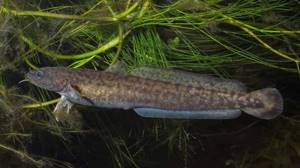
Baits for burbot fishing
Predatory fish prefer baits of animal origin. It is difficult to understand what kind of bait burbot likes in a particular body of water.
It is recommended to try all baits. The most popular of them:
- worms Red dung worms, placed on a hook in the amount of 7–10 pieces, are suitable;
- shrimp. The fish is attracted to raw shrimp, but under certain circumstances it prefers cooked bait;
- cancer. It cannot be considered a favorite food. But if there are a lot of crayfish in the reservoir, the burbot has to get used to such food;
- larvae of various insects. Large numbers of large larvae are attached to the hook. They create a bunch that attracts fish with their smell;
- leeches. When fishing for burbot, choose large and juicy leeches;
- Chicken or goose liver is used. When catching a predator, use any chicken giblets;
- crawls out like a leech - the more the better;
- frogs. Use juveniles. They attract the attention of the fish as much as possible;
- live bait Gobies, minnows, and ruffs are suitable here. The fish is hooked behind its back;
- dead fish. Cut pieces of suitable sizes attract inactive fish due to their accessibility.
Read more
What to feed crucian carp?
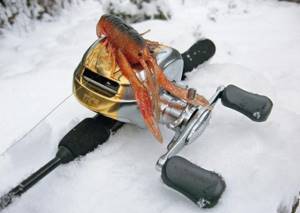
Color in baits for burbot is not the main thing
In addition to the main baits for burbot, lard also often produces positive results. Burbot is often caught by spinners hunting for perch or pike perch. But this applies to random bites, because burbot is not considered an object for fishing with a spinning rod. The time of year plays an important role when choosing bait for a predator.
Lures that attract fish in the summer are often ineffective in cold weather. Its changes affect the decrease or increase in the activity of living organisms that serve as food for fish.
Autumn baits
In the fall, burbot baits should have high nutritional value. It is recommended to use a variety of protein-rich baits. Experienced fishermen resort to a trick - they put a large bunch of crawlers on the hook. It minimizes the bite of small fish. But if one bites, it will automatically become a live bait.
Winter attachments
Unlike other fish species, with the onset of cold weather, burbot becomes more active. The activation of the predator forces anglers to use the same active baits. Live bait is the best bait for burbot in winter. Make sure he remains alive and active. The burbot senses all its vibrations at a great distance.

The amount of bait depends on its size
Spring tips
It is generally accepted that in the spring, most burbot individuals prefer frogs. But in bodies of water where they are considered natural inhabitants. In other bodies of water, the best bait for burbot is selected through experimentation.
Summer tips
In the summer, the predator does not please with its activity. In extreme heat, it often hibernates. The activity of burbot largely depends on the water temperature and the region where the reservoir is located. In the summer, start trying to fish with pieces of fish and other fixed bait. She will not try to swim away from the predator, which is what attracts the sluggish burbot.
Best bait
The time of year and the characteristics of the reservoir largely influence the gastronomic preferences of burbot. But there are classic baits that can attract a predator at any time of the year and under any circumstances. Burbot cannot refuse live bait in the form of perch or ruffe.
In order for live bait to please you with its high efficiency, it is recommended to catch it in the same body of water where you are going to catch burbot. The familiar smell of the bait will definitely attract the attention of a predator. Choose palm-sized perch or ruff. This is the best option when catching medium-sized burbot.
Read more
DIY crucian carp baits: recipes
The best organic baits for burbot
Among the most popular and effective baits for burbot are the following:
- Live fish. Very often they use ruffs, minnows, and gobies. The fish must be hooked behind the back. The bait needs to be checked, as burbot can simply eat the bait without getting hooked.
- Dead fish. Burbot sometimes gives it greater preference than live ones. This is explained by the not too high activity of burbot.
- Red worms. Such bait should be placed on the hook in a bunch, and not singly. Burbot does not see very well and may simply not notice a small worm.
- Fresh frozen fish . Capelin will do. There is no need to defrost before inserting; it may lose its shape.
- Frogs. It is better to take cubs, they are more attractive to burbot.
- Shrimps. You can take both boiled and raw.
- Chicken giblets.
- Insect larvae.
- Leeches. The juicier and larger it is, the better.
Other baits
When fishing for burbot, artificial baits are not used as often as organic ones. Since this fish uses smell and hearing rather than vision when feeding, preference should be given to baits that make a ringing sound. For example, spinners with a special large winding ring. The bait should be chosen preferably silver in color.
They also lure burbot with light . To do this, make fires in the shallows or simply use a flashlight.
Homemade jigs are also used to catch this fish. They should be large and cone-shaped. You can use not one, but several hooks. They also like to catch burbot using a donk; some fishermen say that with its help they catch much more fish.
Features of choosing bait and bait for burbot
From season
The best time to catch burbot is from mid-October to early May. Burbot is most active during the cold season. A break in fishing may occur during spawning.
In the summer, it is almost impossible to lure burbot out of hiding; the fish is very sleepy and does not bite well. The best time in summer is cloudy, cold weather. You can use dead and frozen fish, frogs, and worms as bait.
A good time to catch burbot is early spring. In bad weather, you can count on a larger catch here than when fishing on a clear day. But it is best to catch burbot at night, because it is at this time that he is not very picky about food; he is also attracted to worms, frogs and any fish.
Winter is the ideal time to catch burbot, and this time should also be used to look for fish sites. Thanks to ice, you can try many places and find out exactly where the fish are. In winter, you can catch burbot with almost any bait: live bait, worms, shrimp, meat.
From the gear used
The most popular gear used in winter is winter bottom fishing rods. If fishing is passive, then they use girders. You can use any fish, worms, chicken giblets, or shrimp as bait. For winter fishing, you can also use tackle for the last vertical lure. Here you can use fillets of any fish, larvae, frogs, worms.
Very often, fishermen use fishing rods with a spoon; fishing rods with a jig are also good. Before choosing bait for a fishing rod with a spoon, you need to remember that you need to choose a fish for bait as close as possible to the fish that burbot feed on.
You can also catch burbot using large homemade jigs; their shape should resemble a cone. You can also attach a smaller tee to the bait. The bait should be light in color and shiny to attract fish. You can also use pieces of dead or frozen fish. Donka for burbot is also popular because it does not require expensive parts. Often fishermen make it themselves. It is recommended to use small pieces of fish as bait, which the burbot knows and often feeds on.
We use shrimp to catch carp and tench
Stores sell already cooked shrimp. They are suitable for fishing tench, carp and other fish. It is better to store them frozen. Upon arrival at the pond, the shrimp will move away, soften and become suitable for fishing.
If we catch large fish, we use whole peeled shrimp. If we catch crucian carp, we clean the shrimp from the shell and tear off the tail. The edible part is cut into pieces the size of a pearl barley grain and placed on a hook.
When fishing for chub, unpeeled shrimp is used. The head, or the hard part located along the shrimp's mouth, is removed.
An interesting method of catching carp with shrimp is used by some fishermen. Usually shrimp are kept in water to keep the meat as soft as possible. They proceed as follows. Take the juice from canned corn and pour it into a box of shrimp. After a few hours, the shrimp will be saturated with this juice and become juicy and soft. This bait is suitable for fishing with float tackle.
The best bait for burbot in winter
Burbot is the only freshwater representative of the cod family. It has excellent taste characteristics, and burbot liver is rightfully considered a true delicacy with many beneficial properties. To catch it, it is important not to make the wrong choice of bait. Although burbot is alert and voracious in winter, it is not at all easy to determine its food preferences. In this article we will analyze the variety of baits and determine the best bait for burbot.
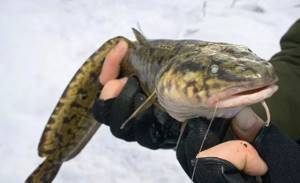
Winter is the favorite season of this bottom predator. Unlike other fish species that lose activity, burbot, on the contrary, is maximally active at this time. When going for burbot, you should stock up on the optimal set of bait, since you never know before fishing which bait for burbot will be the best today.
Live bait baits
These tackles are the most practical, simple and catchy in conditions of a dark and cold night, when in the weak light of a flashlight and fingers stiff from the cold it is difficult to handle thin rigs. And burbot is not very demanding on the elegance of the tackle and the thinness of the fishing line. Large hooks also do not make him suspicious.
But unlike a simple cast, which consists of a thick main line, a heavy sinker and a leash with a hook above it, the rig for large burbot may have some peculiarities. In order for a large burbot to reliably grab the live bait, it is better to bait the fish not under the dorsal fin, which often leads to the bait falling off and the predator leaving, but by passing the leash under one of the gill covers and bringing the hook into the mouth of the bait fish. The picture shows this method using a homemade Finnish hook.
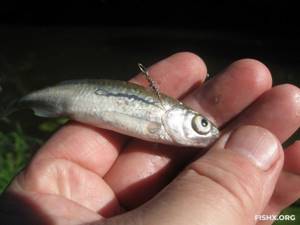
But such equipment is more suitable for pike, although large burbot will fall on such a hook. It's another matter if a smaller fish grabs it. Then the burbot can prick and throw the bait. Finnish hook - for pike and trophy burbot. And for a river where medium-sized nocturnal predators are found, it is better to equip live bait baits with factory doubles, preferably with a short fore-end so that it does not reach the gills of the live bait. Otherwise, he will quickly lose mobility.
This method of baiting with live bait is best used on large burbot, both with live fish and dead fish. Burbot readily grabs dead fish, although, of course, live bait has more advantages, in particular, a live smell and vibrations from movement in the water.
General requirements for choosing bait
There are several requirements for burbot bait in winter:
- It has a fairly large mouth, so the bait must be of an appropriate size. When using live bait, its length should be in the range of 7–10 centimeters. If you fish with worms, you need to take a bunch of 5–7 pieces. This predator may not even notice a single worm on a hook;
- the color of the bait has no meaning due to the poor vision of the predator;
- the bait should have a pleasant smell and, if using live bait, the sound that comes from it. This is due to their excellent sense of smell and hearing.
Features of choosing bait for burbot
Content
At one time, burbot prefers live bait, at another - pieces of dead fish. The main rule for choosing a bait when fishing is to study the reservoir. If a large number of crayfish are present, the fish considers them a delicacy. You will understand what kind of bait burbot bites on if you study the characteristics of the reservoir. Fish prefer food that is abundant in a particular place. Given this feature, it is easy for an angler to choose the best bait for a particular situation.
Regardless of what bait you use to catch burbot, make sure it is fresh. The recommended length of the nozzle is from 7 to 15 centimeters. The use of large bait is explained by the presence of a large mouth. Choose the appropriate nozzle. Worms and crawlers are planted in large bunches. The predator will not notice single specimens. The color of the bait does not matter when catching burbot. He does not have sharp eyesight. However, an excellent sense of smell allows you to smell the bait from a great distance.
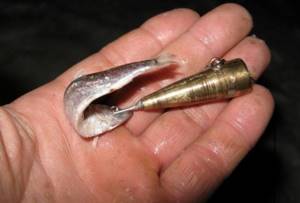
Natural bait must be fresh
Live fish
Live bait is rightfully considered the most popular bait. This bait is used throughout the year and regardless of the characteristics of the reservoir. But not every fish is able to interest a predator. It is better to use the fish that lives in the reservoir as live bait. The ideal option would be to use ruffe or perch caught here as live bait. This is the bait that will provide the best results. Burbot readily bites on gudgeon and goby. Perch, ruffe, and gudgeon are typical bottom fish that are natural food for the predator.
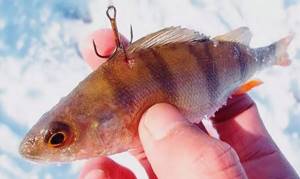
If you use a fish that is unfamiliar to burbot as live bait, the result can be disastrous, and there will be no bites at all.
It’s better to take live bait a little smaller than your palm. It is difficult for him to cope with larger live fish, and small specimens may not interest him. The fish is hooked through the back. It is important not to damage the internal organs of the fish so that it remains alive as long as possible. It is worth checking the condition of the live bait periodically, since burbot can simply eat it without hitting the hook.
The advantage of using live bait as bait is its availability. This fact, coupled with the fact that live bait is a tasty meal for burbot, makes it the most popular bait during the winter months.
Dead fish
In addition to live fish, burbot does not refuse dead fish, which emit a specific smell that attracts predators. In addition, a stationary bait does not require active action. All you have to do is open your mouth. Such taste characteristics of burbot greatly simplify the task of fishermen: they do not need to worry about the safety of their live bait. In addition, the predator cuts itself.
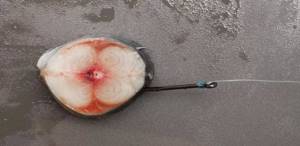
This representative of cod responds well to anchovy, sprat and stale goby. Many anglers prefer to catch it on pieces of crucian carp. Small crucian carp are cut into two parts and placed on a hook. Large specimens are caught well with this bait, but small fish do not touch it. The dead fish holds tightly to the hook, so you can make long casts without fear of losing the bait.
How to put live bait on a hook: classic method No. 1
If you are not a fan of experimenting and inventing anything, then the classic method is suitable for you - by the dorsal fin. This method is definitely the most popular because it is both simple and very effective. When baited in this way, the bait on the hook looks very natural, slightly showing signs of a wounded fish, which acts on the predator as a call to attack.
But, in order to successfully catch a predator using this method of baiting with live bait, you need to know several very important rules in order to use the effectiveness of the method at 100%.
So, it is very important to bait the bait in such a way that it causes minimal harm to it and it remains active for as long as possible. To do this, it is enough just not to damage the fish’s ridge, which runs approximately in the center of its body. Try to insert the sting about 3 mm below the fin, then the live bait will stay securely on the hook, and its spine will remain intact.
As a result, your bait will be active for a long time and actively attract a predator all this time. Predator bites on dead live bait will occur much less frequently, or pike, perch or pike perch will not be interested in it at all.
The second important point is that the position of the live bait should be as natural as possible. In its natural environment, the fish usually swarms in the ground in search of food, so its usual position is at an angle to the bottom with its tail slightly upward. Therefore, when placing live bait on a hook, you need to hook it slightly moving the center of gravity forward so that the head tilts.
It doesn’t matter how much the bait fish’s head is tilted; you can experiment with different tilt angles. But, approximately, it should be at an angle of 30-45° to the bottom.
Attention: live bait hooks under the dorsal fin with only one hook, regardless of whether you use a single hook, a double hook or a treble hook.
Other baits
A variety of baits are used to catch burbot. Among them are bunches of red worms, chicken giblets, crawlies, and leeches. But the real delicacy is crayfish and frog meat. All kinds of attractants are often used. The predator bites on all of the above baits. Some are better, others are worse, but they bite. In its diet, burbot is very similar to catfish. Often, tackle with a spinner or jig is good for catching burbot.
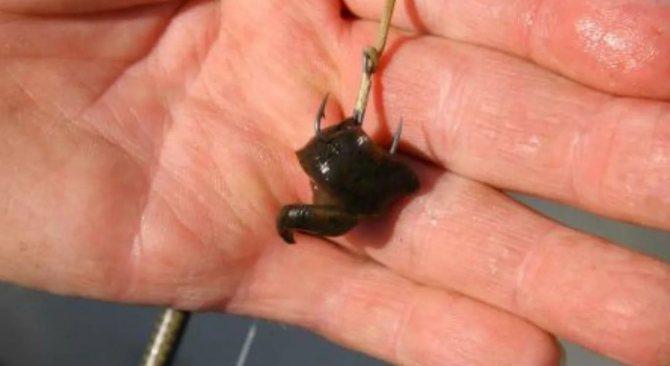
When catching a predator, experienced burbot fishermen inspect its belly in order to determine the most catchable bait. If undigested fish are found in the belly, you should catch them with live bait. If crayfish are found, you can try to take them as bait. The risk of using worms is that they can be eaten by small fish.
Silicone baits are practically not used for catching burbot, since the predator uses smell and hearing when feeding. In this regard, baits that make a ringing sound are more advantageous.
The unpretentiousness of burbot in nutrition opens up a creative approach for some fishermen when choosing bait. And the most savvy ones succeed in this. Thus, when going for burbot, you should prepare a wide variety of tasty treats, but still the best bait for burbot is live bait!
Baits for catching burbot
Burbot is caught using a variety of baits, the most common of which are:
- live bait;
- pieces of fish;
- dead fish;
- frog;
- bunch of worms;
- crawl out;
- chicken liver;
- cancer;
- shrimp;
- leech;
- insect larvae.
Burbot can also be caught on a spinning rod, but this is usually a side effect or rather a surprise when catching other fish, such as pike perch and perch. That is, there is no regular burbot bite on spinning baits, but sometimes you can accidentally hook one. What can we say about catching burbot with a spinning rod, if it is not always possible to pull out a pike, although it is the main object of spinning fishing.
Burbot can be caught using any of the above baits. One is better, the other is worse, but it is caught. In some reservoirs, it will be appropriate to look at the contents of its belly when catching burbot. If you find small crayfish in it, then this bait is ideal for catching it, and if there are undigested fish there, then it is better to fish with live bait or dead fish.
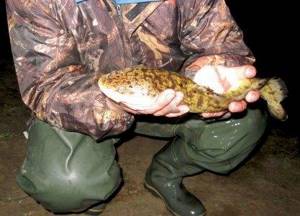
The recommended bait for burbot in the fall is a bunch of dung worms or crawlers. Burbot happily eats worms, but such bait runs the risk of being eaten by small fish. A bunch of worms or crawling usually scares away small fish, but still. And if a burbot approaches her, then she will certainly become his prey, and the burbot yours.
The recommended bait for burbot in winter is live bait. Winter is the favorite time of year for burbot. While other fish lose activity, and some even hibernate, burbot becomes more active and at this time live bait is the best bait for burbot.
The recommended bait for burbot in the spring is a frog. In spring, burbot responds well to frogs, which can be excellent bait at this time of year. Many fishermen advise using small frogs to catch burbot in the spring. But this rule is not suitable for all reservoirs; in some reservoirs in the spring, burbot may prefer other bait, although it will not refuse a frog anywhere.
The recommended bait for burbot in the summer is again a crawler or a bunch of worms. In summer, burbot is least active and its bite is possible only in inclement weather. Therefore, for fishing during this period, the simplest bait is suitable - a worm.

